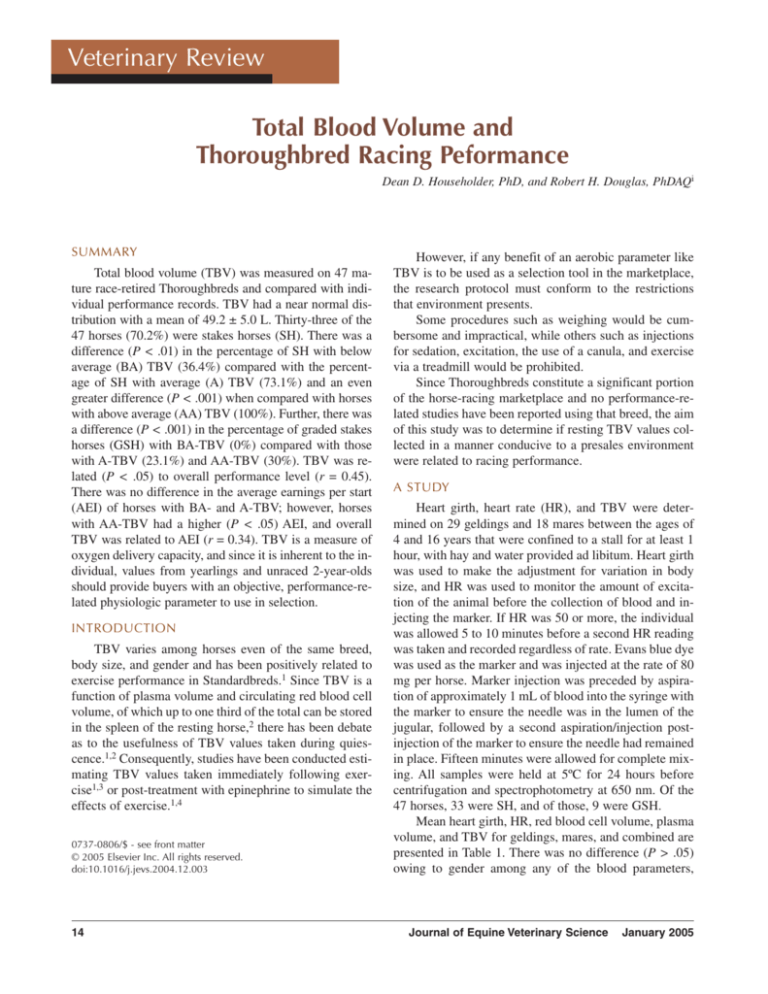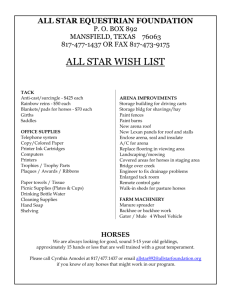
Veterinary Review
Total Blood Volume and
Thoroughbred Racing Peformance
Dean D. Householder, PhD, and Robert H. Douglas, PhDAQi
SUMMARY
Total blood volume (TBV) was measured on 47 mature race-retired Thoroughbreds and compared with individual performance records. TBV had a near normal distribution with a mean of 49.2 ± 5.0 L. Thirty-three of the
47 horses (70.2%) were stakes horses (SH). There was a
difference (P < .01) in the percentage of SH with below
average (BA) TBV (36.4%) compared with the percentage of SH with average (A) TBV (73.1%) and an even
greater difference (P < .001) when compared with horses
with above average (AA) TBV (100%). Further, there was
a difference (P < .001) in the percentage of graded stakes
horses (GSH) with BA-TBV (0%) compared with those
with A-TBV (23.1%) and AA-TBV (30%). TBV was related (P < .05) to overall performance level (r = 0.45).
There was no difference in the average earnings per start
(AEI) of horses with BA- and A-TBV; however, horses
with AA-TBV had a higher (P < .05) AEI, and overall
TBV was related to AEI (r = 0.34). TBV is a measure of
oxygen delivery capacity, and since it is inherent to the individual, values from yearlings and unraced 2-year-olds
should provide buyers with an objective, performance-related physiologic parameter to use in selection.
INTRODUCTION
TBV varies among horses even of the same breed,
body size, and gender and has been positively related to
exercise performance in Standardbreds.1 Since TBV is a
function of plasma volume and circulating red blood cell
volume, of which up to one third of the total can be stored
in the spleen of the resting horse,2 there has been debate
as to the usefulness of TBV values taken during quiescence.1,2 Consequently, studies have been conducted estimating TBV values taken immediately following exercise1,3 or post-treatment with epinephrine to simulate the
effects of exercise.1,4
0737-0806/$ - see front matter
© 2005 Elsevier Inc. All rights reserved.
doi:10.1016/j.jevs.2004.12.003
14
However, if any benefit of an aerobic parameter like
TBV is to be used as a selection tool in the marketplace,
the research protocol must conform to the restrictions
that environment presents.
Some procedures such as weighing would be cumbersome and impractical, while others such as injections
for sedation, excitation, the use of a canula, and exercise
via a treadmill would be prohibited.
Since Thoroughbreds constitute a significant portion
of the horse-racing marketplace and no performance-related studies have been reported using that breed, the aim
of this study was to determine if resting TBV values collected in a manner conducive to a presales environment
were related to racing performance.
A STUDY
Heart girth, heart rate (HR), and TBV were determined on 29 geldings and 18 mares between the ages of
4 and 16 years that were confined to a stall for at least 1
hour, with hay and water provided ad libitum. Heart girth
was used to make the adjustment for variation in body
size, and HR was used to monitor the amount of excitation of the animal before the collection of blood and injecting the marker. If HR was 50 or more, the individual
was allowed 5 to 10 minutes before a second HR reading
was taken and recorded regardless of rate. Evans blue dye
was used as the marker and was injected at the rate of 80
mg per horse. Marker injection was preceded by aspiration of approximately 1 mL of blood into the syringe with
the marker to ensure the needle was in the lumen of the
jugular, followed by a second aspiration/injection postinjection of the marker to ensure the needle had remained
in place. Fifteen minutes were allowed for complete mixing. All samples were held at 5ºC for 24 hours before
centrifugation and spectrophotometry at 650 nm. Of the
47 horses, 33 were SH, and of those, 9 were GSH.
Mean heart girth, HR, red blood cell volume, plasma
volume, and TBV for geldings, mares, and combined are
presented in Table 1. There was no difference (P > .05)
owing to gender among any of the blood parameters,
Journal of Equine Veterinary Science
January 2005
Table 1
Mean ± SD for HG, HR, RCV, PV, and TBV for Geldings, Mares, and Combined
No./Gender
HG
HR
RCV
PV(L)
TBV(L)
29/Geldings
18/Mares
47/Total
73.4 ± 2.8a
75.6 ± 2.7b
74.2 ± 3.0
45.7 ± 4.2
44.6 ± 3.9
45.3 ± 4.1
38.3 ± 2.8
38.3 ± 2.9
38.3 ± 2.8
29.8 ± 3.4
31.2 ± 3.2
30.3 ± 3.4
48.4 ± 5.1
50.5 ± 4.6
49.2 ± 5.0
a,bNumbers
within columns are different (P < .01).
HG, heart girth; HR, heart rate; RCV, red blood cell volume; PV, plasma volume; TBV, total blood volume.
Table 2
Mean TBV, % SH, GSH, and mean AEI for
horses with BA-, A-, and AA-TBV
No./Group
SH/Horses(%)
GSH/Horses(%)
AEI
11/BA-TBV
26/A-TBV
10/AA-TBV
4/11 (36.4)ac
19/26 (73.1)d
10/10 (100)b
0/11 (0.0)a
6/26 (23.1)b
3/10 (30.0)b
2.3e
3.7e
10.8f
Numbers within columns with different superscripts are different.
a,b(P < .001); c,d(P < .01); e,f(P < .05)
A, average; AA, above average; AEI, average earnings per start; BA, below
average; GSH, graded stakes horses; SH, stakes horses; TBV, total blood
volume.
which agrees with reports by Persson1 that unlike stallions, there was no difference in mean TBV between mature mares and geldings in Standardbreds. Mean variation (SD/mean) was 10.8% for geldings and 9.1% for
mares, with an overall mean variation of 10.2%. This was
in agreement with Persson5 that TBV varied approximately 10% among Standardbreds of the same age and
gender after correction for body size. There was a trend
toward mares having a higher (50.5 L) TBV compared
with geldings (48.4 L); however this trend was likely due
to the fact that 17 of the 18 mares were SH or GSH,
whereas only 16 of the 29 geldings were SH or GSH. A
repeatability trial consisting of 3 horses where TBV was
determined on 4 different occasions yielded a coefficient
of variation of 3.2%.
Horses were grouped by BA-, A-, or AA-TBV depending on whether their TBV was less than, within, or
more than 4 L from the mean. There was a difference (P <
.01) in the percentage of SH with BA-TBV compared with
those with A-TBV and an even greater difference (P <
.001) when compared with the percentage of SH with AATBV (Table 2). Although there was no difference (P > .05)
in the percentage of GSH with A- and AA-TBV, there was
a large difference (P < .001) between these 2 groups and
the BA-TBV group, which had 0.0 GSH. TBV was related
(P < .05) to overall performance level (r = 0.45). Since
some SH and GSH can earn significantly more than others,
which impacts their residual value, TBV was compared
Volume 25, Number 1
with AEI. Although there was no difference (P > .05) in
AEI between horses with BA-TBV (2.5) and A-TBV (3.8),
horses with AA-TBV earned more (P < .05) per start
(11.2), and overall, TBV was related (P < .05) to AEI (r
=0.34). Mean TBV was higher (P < .01) for the 33 SH
(50.4 L) compared with the 14 non-SH (46.2 L).
CONCLUSIONS
Racing performance is based on many factors, but mechanical efficiency, which affects oxygen demand, and the
individual’s physiologic capacity to supply that demand
are central. Of the aerobic indices, TBV, by virtue of its
role during exercise, may well be the most comprehensive
indicator of oxygen delivery capacity. The purpose of this
study was to determine not only if TBV values taken at rest
were associated with performance, but also how this value
was distributed in a performance-rich population. The results indicate that even when tested in a high-performance
group, TBV was still an effective indicator, placing 50% (7
of 14) of the non-stakes performers in the BA-TBV group
and the remaining in the A-TBV group. Since horses with
AA-TBV earned significantly more per start than the others, TBV would be useful in increasing the chances of selecting not only SH, but horses with greater earnings potential. Since TBV is inherent to the individual, the results
of this study indicate this should be an effective selection
tool in the yearling and 2-year-old marketplace.
REFERENCES
1.
2.
3.
4.
5.
Persson SGB. On blood volume and working capacities in horses.
Acta Veterinaria Scandinavica 1967;19:1-189.
Torten M, Schalm OW. Influence of the equine spleen on rapid
changes in the concentration of erythrocytes in peripheral blood.
Am J Vet Res. 1964;25:500-3.
Lane T, Lane R, Hintz HF, Schryver HF. Effect of sampling times,
type of activity and conditioning on total plasma volume, total
red-cell volume and total blood volume as measured by Evans
blue dye dilution. Proceedings of 11th Equine Nutrition Physiology Symposium. 1989;11:65-9.
Hanson CM, Kline KH, Foreman JH, Frey LP, Cooper SM. Relating
heart and spleen size to blood volume parameters in racing and
draft types. Manuscript, Departments of Animal Sciences and
Veterinary Clinical Medicine, University of Illinois, Urbana; 1994.
Persson SGB, Ullberg LE. Blood volume in relation to exercise tolerance in trotters. J S Afr Vet Assoc1974;45(4):293-9.
15









